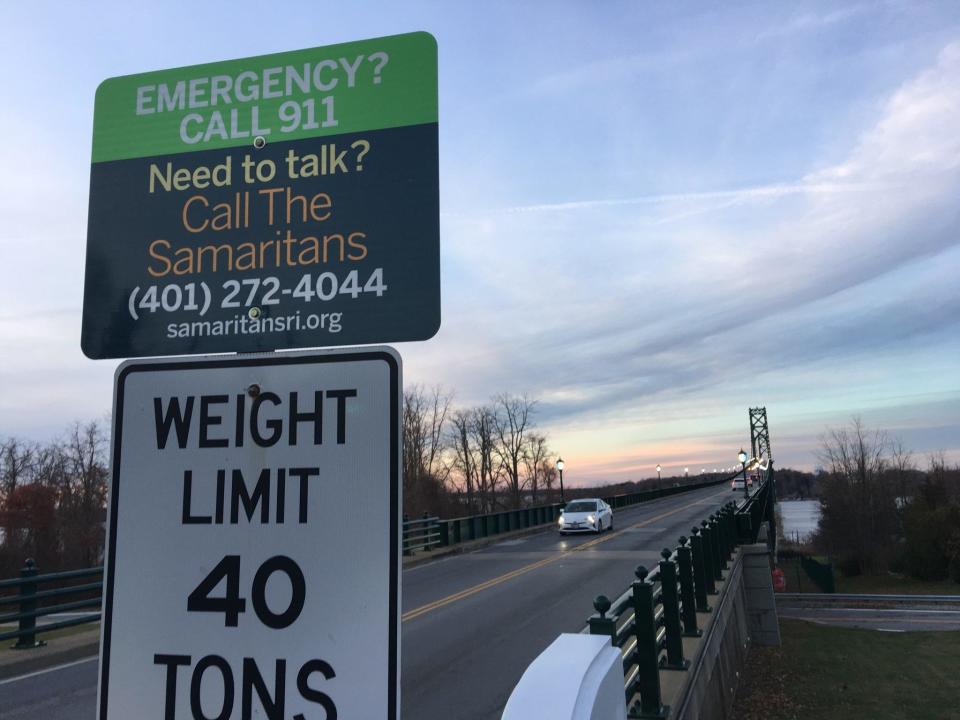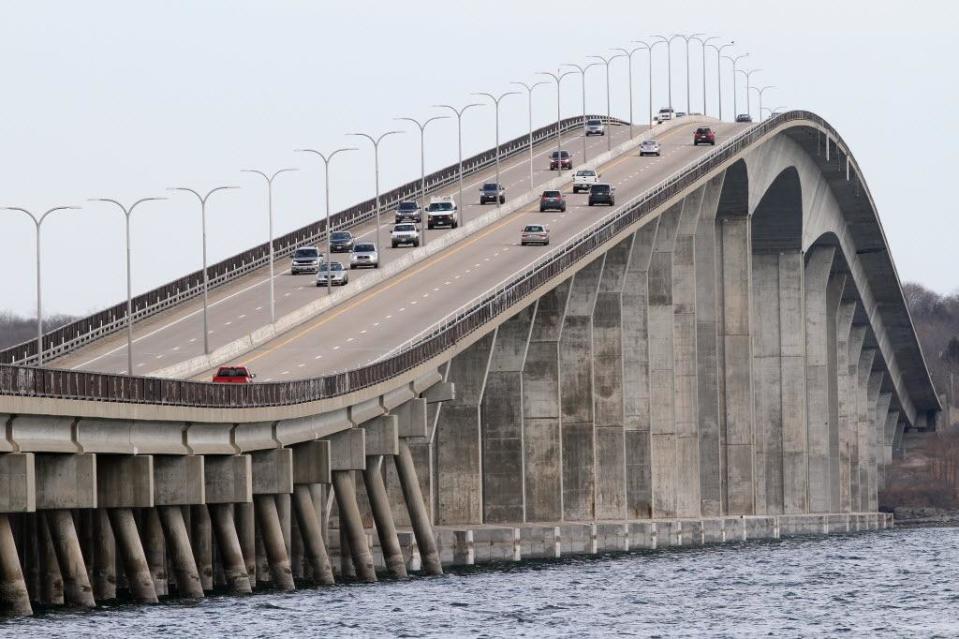A suicide barrier study has been approved by RITBA. Why it will only be on two bridges.
JAMESTOWN – Rhode Island Turnpike and Bridge Authority board members voted unanimously on Wednesday to approve the task order for a safety barrier feasibility study on the Mount Hope and Jamestown Verrazzano bridges.
The task order from Atkins, a British multinational engineering company, is expected to come in next week and cost just under a million dollars. RITBA’s initial projected timeline, first reported by the East Bay media group in August, posited a start of data collection in January 2023 and the issuance of a final feasibility report in February 2024.
Melissa Cotta, who seven years ago co-founded a suicide prevention advocacy group called Bridging the Gap for Safety & Healing which has played a key role in lobbying for safety barriers on Rhode Island’s suspension bridges, offered public comment at Wednesday’s RITBA meeting. She, along with her fellow advocates Jenny Gaynor and Mark Gonsalves, think the state needs to address the need for safety barriers with more urgency.

“Unless you, the Rhode Island bridge authority, begin to act with steadfast intent and true urgency to get safety barriers up on the bridges you oversee, many more people are going to die,” Cotta said to the RITBA board.
Gaynor, who grew up on Aquidneck Island but now lives in Barrington, started working with Cotta about four months ago in the wake of losing two friends to suicide within the span of three months. Both took their own lives by jumping off the Mount Hope Bridge.
Speaking after Cotta, Gaynor grew emotional as she told the board about her friends. After explaining how they passed and expressing her belief that a barrier may have forced them to pause and reconsider their decision to jump, she said:
“I’m still struggling to wrap my head around losing two friends to suicide….to losing two friends off bridges that I have spent my life driving over, sailing under and admiring. Just a little over a month since I’ve lost my two friends, I am shaking off my sorrow and channeling my grief toward my new mission….to make mental health a priority, raise awareness and advocate for building barriers on our local bridges.”
Gonsalves became a suicide prevention advocate and specifically an advocate of bridge safety barriers after he improbably survived a leap off the Newport Pell Bridge in 2015 despite injuries that included multiple broken ribs, multiple broken spinal vertebrae, a broken left wrist, blood clots, and lungs damaged from both impact and submersion.
Redemption:The fall and rise of Mark Gonsalves
“People choose suicide by bridge because it’s the easiest access to suicide,” Gonsalves told The Daily News after Wednesday's meeting. “I climbed over a week before (I jumped), but my girlfriend was with me and stopped me. A week later…I drove like a hundred miles per hour to the top, slung the door open, the railing is only 42 inches. I was on top of the railing like that,” he said as he snapped his fingers.
State did not provide sufficient funding to conduct a feasibility study on all four bridges
Gonsalves, who said he was not only distraught but also under the influence when he decided to jump, thinks safety barriers would save the lives of people who make a similar impulse decision when they are feeling low. He, Gaynor and Cotta all spoke to the RITBA board about the urgent need for the state to provide enough funding to study all four bridges – the Mount Hope, the Newport Pell, the Jamestown Verrazzano and the Sakonnet River bridge.
Bridge safety:State budget includes $1 million for bridge suicide barrier design; House vote Thursday
However, RITBA received only two-thirds of the $1.5 million they requested from the state, forcing them to choose which of the four bridges to study with the $1 million ARPA fund allocation.
Eric Seabury, RITBA’s director of engineering, told The Daily News, “The total task order amount (from Atkins) came in actually slightly north of $1.5 million for the four bridges. Because we were constrained by the available funding, we decided we needed to look at which of the bridges we could fit and maximize that $1 million amount.”
He acknowledged the two suspension bridges present the highest suicide risk, but explained the suspension bridges require more complex and thus more expensive analyses than the structural bridges.
“The bridge barrier studies, the installation of temporary barriers and then the permanent barriers must not be delayed further for any reason. You can choose to do the right thing and choose to make bridge safety for all your priority.”
Melissa Cotta, Bridging the Gap for Safety & Healing
“We first looked at Newport and Mt. Hope as the two bridges,” said Seabury. “The problem with doing those two is they require the most complex analyses – they involve wind analysis because they’re both suspension bridges. The cost of each of those is approximately between $650,000 and $750,000 each. The Jamestown bridge and the Sakonnet River bridge being completely different structures – they’re more rigid and they don’t have the suspension components – they’re more like $220,000- $250,000 apiece. So we can only do one suspension and one of the other bridges.”
When The Daily News asked RITBA Executive Director Lori Caron Silveira about the possibility of RITBA using its own budget to fill the funding gap, she explained the agency, which is funded by toll revenue bonds and gas tax bonds, is limited by the wording of its bond covenant in the ways it can spend its revenue.
“The toll indenture pledges the net revenue to the bondholders and the only exception to that is operating expenses of what’s called ‘the system,’ and the system is the Pell and the Mt. Hope,” said Silveira. “So there’s a question of whether this feasibility study fits that definition, which is why we were thrilled to get the ARPA money.”
She explained further, “There’s a serious question on a legal level of whether this (study) would be an appropriate use that would not be in violation of the bond covenant. If you were a bondholder, you could make the argument this study is not a current expense of maintenance repair and operation of the Pell and the Mount Hope… Everything we do here, we have to ensure we are in compliance with our bond covenant.”

Silveira indicated RITBA would be pursuing additional state funding to conduct a feasibility study on the Newport Pell bridge once the General Assembly reconvenes in January, and state Sen. Louis DiPalma told The Daily News securing the additional funding was a priority for him in the next legislative session, adding that he was concerned the Newport Pell bridge was not currently included in the study given the available data on bridge suicides in Rhode Island.
Suicide prevention advocates are concerned by state’s lack of urgency
An email sent from the Department of Health to DiPalma and obtained by The Daily News explained the Rhode Island Violent Death Reporting System collects injury location (i.e. bridge), allowing the department to track bridge-related suicides, but does not usually note the bridge name. As a result, bridge suicides are reported by county (not ideal, given the Mount Hope Bridge connects two different counties). A total of 48 bridge-related suicides were identified during 2011-2022 and 27 of those deaths occurred in Newport County. While the state’s data for 2021 and 2022 are not yet finalized, there is a preliminary total of 13 suicides over the past two years, with nine of those suicides occurring in Newport County.
Cotta has seen firsthand through her advocacy work what the numbers suggest: the rate of bridge suicides in Rhode Island has increased in recent years. Newport County has seen 27 officially logged bridge suicides since 2011, and one-third of those suicides occurred in the past two years alone. Thus, Cotta and her fellow suicide prevention advocates are frustrated at the glacial pace of the government funding process in the face of what they see as an urgent, deadly problem.
Bridge repairs:Newport Pell Bridge awarded 'enormous federal grant.' This is what that money will do.
“The bridge barrier studies, the installation of temporary barriers and then the permanent barriers must not be delayed further for any reason,” Cotta told the RITBA board. “You can choose to do the right thing and choose to make bridge safety for all your priority.”
Silveira and Seabury both told The Daily News the study is going to take over a year to do, with Seabury citing a schedule Atkins provided to RITBA which indicates the company needs about 16 months to complete the analysis.
“I know this company has been inquiring about when they’ll be asked to mobilize, so I expect it to be quick,” said Silveira. "It’s going to be winter, so there are some weather factors, but I’m certain they’re not going to waste any time. In the meantime, I hope we will be talking with the General Assembly about funding the study of the other suspension bridge, the Pell.”
"We’re still talking with the state on the aspect of getting the additional funding to do the other two bridges, and we’re prepared to move forward if we can get the additional funding secured,” said Seabury. “Our RFQ process included all four bridges so we’re already covered – we can literally just go right to the consultant and say, ‘Let’s discuss these other two bridges, let’s come up with a task order and do those,’ and that can be moved forward in concert with the other one.”
The National Suicide Prevention Lifeline is a hotline for individuals in crisis or for those looking to help someone else. To speak with a certified listener, call 1-800-273-8255.
This article originally appeared on Newport Daily News: Suicide barrier study planned for Mount Hope, Jamestown bridges

